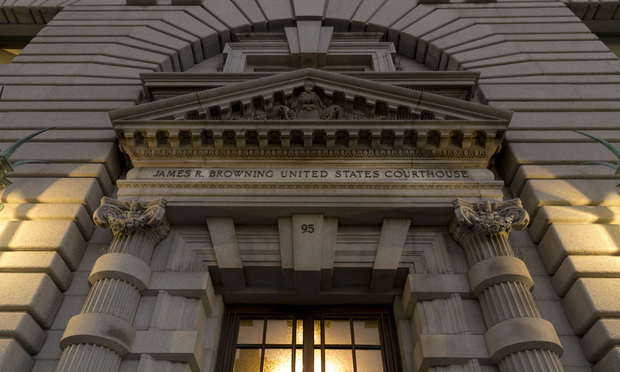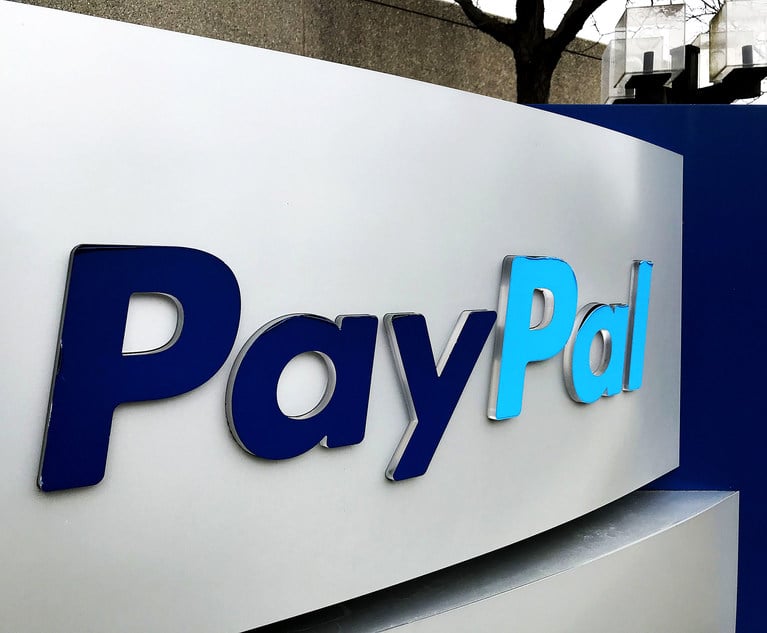Ninth Circuit Sharply Limits Pre-Certification Discovery Into the Identity of Other Class Members
While the Ninth Circuit's decision reflects a welcome concern about the use of pre-certification discovery to identify potential clients, it further exacerbates the stark contrasts between class action practice in California state courts and California federal courts.
March 12, 2020 at 01:19 PM
7 minute read
 U.S. Court of Appeal for the Ninth Circuit in San Francisco, Calif. (Photo: Jason Doiy/ALM)
U.S. Court of Appeal for the Ninth Circuit in San Francisco, Calif. (Photo: Jason Doiy/ALM)
This is the latest in the series of Consumer Law Watch columns from lawyers at Jenner & Block tracking the latest in privacy/cybersecurity, fintech, food & beverage, trade secrets, and other developments affecting consumer law in California.
In class actions, named plaintiffs frequently seek discovery from the defendant regarding the identities and contact information of other putative class members. While some view this practice as a normal method of obtaining information about other similarly situated consumers, others view it as a way for plaintiffs' lawyers to fish for potential plaintiffs—either in new lawsuits, or as a "backup" in the event the court finds the original named plaintiff atypical or inadequate.
In spite of these concerns about fishing expeditions, California state courts have consistently permitted named plaintiffs in class actions to obtain pre-certification discovery regarding the names and contact information of other putative class members. Indeed, the California Supreme Court has repeatedly blessed this practice, holding that the interests of named plaintiffs in seeking relief on behalf of similarly situated consumers—and the broad scope of discovery under California law—weighed in favor of requiring defendants to identify other potential members of the class. See Pioneer Elecs. (USA) v. Superior Court, 40 Cal. 4th 360, 373-74 (2007); Williams v. Superior Court, 3 Cal. 5th 531, 547 (2017).
In a sharp divergence from this line of cases, however, the Ninth Circuit held earlier this year that a named plaintiff in a class action is not entitled to pre-certification discovery regarding the identities of other putative class members. See In re Williams-Sonoma, 947 F.3d 535 (9th Cir. 2020). While the Ninth Circuit's decision reflects a welcome concern about the use of pre-certification discovery to identify potential clients, it further exacerbates the stark contrasts between class action practice in California state courts and California federal courts.
Williams-Sonoma
In Williams-Sonoma, the named plaintiff—a Kentucky resident—allegedly purchased bedding from Williams-Sonoma in reliance on the advertised thread count of 600 threads per square inch. When the plaintiff allegedly discovered that this representation was false, he filed a class action in the Northern District of California on behalf of a putative class of consumers who bought bedding from Williams-Sonoma based on the same thread count representations. Before a class was certified, the district court determined that the plaintiff could not assert his claim on a class-wide basis, as Kentucky consumer law governed his individual claims and barred class actions. The named plaintiff informed the district court that he would pursue his individual claims in Kentucky, but sought discovery from Williams-Sonoma to identify a California purchaser who might be willing to serve as a named plaintiff in his stead.
Over Williams-Sonoma's objections, the district court ordered Williams-Sonoma to produce a list of all California consumers who had purchased the bedding at issue since January 2012. Williams-Sonoma then filed a petition for a writ of mandamus, and the Ninth Circuit—in a divided opinion—granted that petition. Relying primarily on Oppenheimer Fund v. Sanders, 437 U.S. 340 (1978), the court held that the district court clearly erred in permitting pre-certification discovery into the identities of absent class members, as the names of absent class members were not "relevant to any party's claim or defense" under Federal Rule of Civil Procedure 26(b)(1). As in Oppenheimer, the court reasoned, "using discovery to find a client to be the named plaintiff before a class action is certified is not within the scope of Rule 26(b)(1)."
Notably, the court did not make any effort to square its holding with the rule embraced by the California Supreme Court. Instead, it emphasized that the district court erred by relying on California discovery rules to justify its order compelling Williams-Sonoma to produce the names of other purchasers, as these rules are not binding in federal court.
Judge Paez dissented. He rejected the majority's reading of Oppenheimer to preclude discovery into the identities of putative class members and held that it "stands for a much narrower proposition"—namely, that class counsel must rely on the procedures set forth in Federal Rule of Civil Procedure 23, rather than the discovery rules set forth in Rule 26 through 37, to identify and notify absent class members that a class had been certified. In fact, Judge Paez explained, the Supreme Court had expressly left open the possibility that Rule 26 would authorize discovery into the identity of absent class members so long as it was "relevant to other issues in the case."
Moreover, aside from Oppenheimer, Judge Paez noted that no federal court had clearly addressed whether Rule 26 could be used to obtain discovery for the purpose of identifying a substitute plaintiff, and he accordingly refused to conclude that the district court's discovery was erroneous—let alone so clearly erroneous as to warrant the extraordinary remedy of mandamus.
And in any event, even if Rule 26 did not authorize discovery into the identities of absent class members, he explained that Rule 23(d) provided an alternative source of authority for that order, as it permits district courts to order the plaintiff to provide notice to putative class members and empowers them to force defendants (such as Williams-Sonoma) to cooperate in this process.
Implications of Williams-Sonoma for Federal Court Practitioners
As the competing opinions illustrate, it is possible to read Williams-Sonoma in any number of ways. For instance, one might read Williams-Sonoma to stand for the broad proposition that the federal discovery rules simply do not permit discovery into the identity of absent class members and that this information is categorically not relevant to the parties' claims or defenses. Indeed, given that the Ninth Circuit found the district court's order so clearly erroneous as to warrant the extraordinary remedy of mandamus, one might conclude that this information is now strictly off-limits.
On the other hand, one could also read Williams-Sonoma much more narrowly. Unusually, the plaintiffs in Williams-Sonoma expressly admitted that their discovery requests were aimed at finding a new plaintiff, rather than discovering information relevant to the merits of the class's claims. Thus, a plaintiff could argue that Williams-Sonoma simply stands for the uncontroversial proposition that discovery must be related to the parties' claims and defenses. And in a similar vein, a plaintiff might argue that Williams-Sonoma no longer applies once a class has been certified: if the court has already concluded that the named plaintiff is an adequate class representative, there is no reason to believe that discovery into the identity of absent class members is aimed at identifying substitute plaintiffs.
At this stage, it is unclear which of these readings courts will adopt. The Ninth Circuit issued its decision in Williams-Sonoma less than two months ago, and no federal court has had occasion to apply that decision since then. But regardless of how broadly or narrowly federal courts read Williams-Sonoma, it adds yet another checkmark to the long list of distinctions between federal and state court class action practice.
 Alex Smith of Jenner & Block (Photo: Courtesy Photo)
Alex Smith of Jenner & Block (Photo: Courtesy Photo)Alex Smith is a Los Angeles-based associate with Jenner & Block who represents consumer product manufacturers in class action litigation.
Read more:
This content has been archived. It is available through our partners, LexisNexis® and Bloomberg Law.
To view this content, please continue to their sites.
Not a Lexis Subscriber?
Subscribe Now
Not a Bloomberg Law Subscriber?
Subscribe Now
NOT FOR REPRINT
© 2025 ALM Global, LLC, All Rights Reserved. Request academic re-use from www.copyright.com. All other uses, submit a request to [email protected]. For more information visit Asset & Logo Licensing.
You Might Like
View All


Starbucks Hands New CLO Hefty Raise, Says He Fosters 'Environment of Courage and Joy'

'It's Not Going to Be Pretty': PayPal, Capital One Face Novel Class Actions Over 'Poaching' Commissions Owed Influencers
Trending Stories
- 1Uber Files RICO Suit Against Plaintiff-Side Firms Alleging Fraudulent Injury Claims
- 2The Law Firm Disrupted: Scrutinizing the Elephant More Than the Mouse
- 3Inherent Diminished Value Damages Unavailable to 3rd-Party Claimants, Court Says
- 4Pa. Defense Firm Sued by Client Over Ex-Eagles Player's $43.5M Med Mal Win
- 5Losses Mount at Morris Manning, but Departing Ex-Chair Stays Bullish About His Old Firm's Future
Who Got The Work
J. Brugh Lower of Gibbons has entered an appearance for industrial equipment supplier Devco Corporation in a pending trademark infringement lawsuit. The suit, accusing the defendant of selling knock-off Graco products, was filed Dec. 18 in New Jersey District Court by Rivkin Radler on behalf of Graco Inc. and Graco Minnesota. The case, assigned to U.S. District Judge Zahid N. Quraishi, is 3:24-cv-11294, Graco Inc. et al v. Devco Corporation.
Who Got The Work
Rebecca Maller-Stein and Kent A. Yalowitz of Arnold & Porter Kaye Scholer have entered their appearances for Hanaco Venture Capital and its executives, Lior Prosor and David Frankel, in a pending securities lawsuit. The action, filed on Dec. 24 in New York Southern District Court by Zell, Aron & Co. on behalf of Goldeneye Advisors, accuses the defendants of negligently and fraudulently managing the plaintiff's $1 million investment. The case, assigned to U.S. District Judge Vernon S. Broderick, is 1:24-cv-09918, Goldeneye Advisors, LLC v. Hanaco Venture Capital, Ltd. et al.
Who Got The Work
Attorneys from A&O Shearman has stepped in as defense counsel for Toronto-Dominion Bank and other defendants in a pending securities class action. The suit, filed Dec. 11 in New York Southern District Court by Bleichmar Fonti & Auld, accuses the defendants of concealing the bank's 'pervasive' deficiencies in regards to its compliance with the Bank Secrecy Act and the quality of its anti-money laundering controls. The case, assigned to U.S. District Judge Arun Subramanian, is 1:24-cv-09445, Gonzalez v. The Toronto-Dominion Bank et al.
Who Got The Work
Crown Castle International, a Pennsylvania company providing shared communications infrastructure, has turned to Luke D. Wolf of Gordon Rees Scully Mansukhani to fend off a pending breach-of-contract lawsuit. The court action, filed Nov. 25 in Michigan Eastern District Court by Hooper Hathaway PC on behalf of The Town Residences LLC, accuses Crown Castle of failing to transfer approximately $30,000 in utility payments from T-Mobile in breach of a roof-top lease and assignment agreement. The case, assigned to U.S. District Judge Susan K. Declercq, is 2:24-cv-13131, The Town Residences LLC v. T-Mobile US, Inc. et al.
Who Got The Work
Wilfred P. Coronato and Daniel M. Schwartz of McCarter & English have stepped in as defense counsel to Electrolux Home Products Inc. in a pending product liability lawsuit. The court action, filed Nov. 26 in New York Eastern District Court by Poulos Lopiccolo PC and Nagel Rice LLP on behalf of David Stern, alleges that the defendant's refrigerators’ drawers and shelving repeatedly break and fall apart within months after purchase. The case, assigned to U.S. District Judge Joan M. Azrack, is 2:24-cv-08204, Stern v. Electrolux Home Products, Inc.
Featured Firms
Law Offices of Gary Martin Hays & Associates, P.C.
(470) 294-1674
Law Offices of Mark E. Salomone
(857) 444-6468
Smith & Hassler
(713) 739-1250






